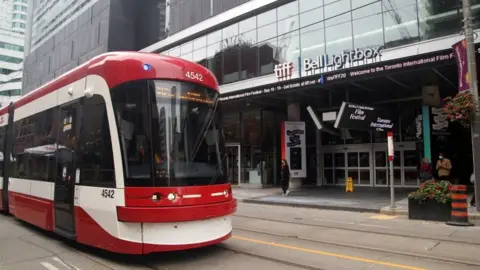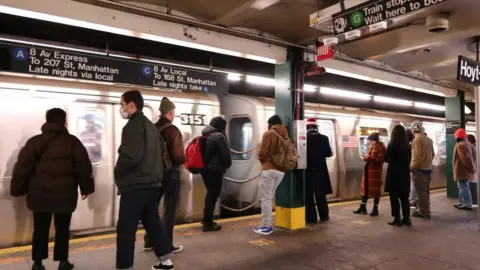Toronto struggles with wave of public transport violence
 Getty Images
Getty ImagesCommuters in Toronto have been navigating the city's public transport system with growing unease, following a surge of violent incidents targeting both riders and operators.
As of Friday, there were seven reported incidents of violence in the last seven days on the transport system of Canada's largest city.
This includes a woman who was stabbed multiple times by a stranger on one of Toronto's iconic streetcars. The next day, a 16-year-old boy was stabbed in the torso on a bus.
In another incident, a bus operator was shot with a BB gun by two teenagers. Four days later, the Toronto Transit Commission (TTC) said two other employees were chased by a person with a syringe at a subway station.
The wave of seemingly random violence has alarmed residents, and has dominated the conversation in Toronto over the last week.
"Every time I'm on the subway, I literally need to hide," said one Toronto woman in a TikTok posted on Thursday. "It's definitely scary, I'm concerned for my safety and (that of) others as well," said another in an interview with local news outlet BlogTo.
On Thursday, the Toronto Police Service responded by announcing that it will deploy more officers to patrol transit stations. During the announcement, Police Chief Myron Demkiw stressed that Toronto remains a safe city.
"A million people travel our city every day using (TTC) subways, streetcars, and buses, safely," he said.
Recent reports show that this issue is not unique to Toronto. A similar surge of violence on transport systems has been observed throughout 2022 in cities across North America, including New York City, Chicago and Washington DC.
How much has violence risen on public transit?
The Toronto Star newspaper has reported that violent incidents on the city's transit system have gone up, even while ridership remains lower than pre-pandemic levels.
In 2021, the paper reported that the TTC recorded 734 instances of violence against customers, including assault, sexual assault, robbery and harassment - a 10% increase from 2019.
In the first half of 2022, the TTC reported 451 instances of violence, putting the year on track for a higher rate of violence than in 2021. Overall major crime in Toronto is up 3% from 2019, according to Toronto Police data.
Violent incidents targeting operators also appear to be increasing. More than half of Toronto's transit workers said in a recent survey that they have experienced violence or harassment on the job.
A similar issue has been observed in other cities like Edmonton and Vancouver, prompting the national union of transit workers to call for a task force to tackle violence against its members.
 Getty Images
Getty ImagesIn the US, cities across the country have also reported significant spikes in crimes on local transit systems.
In New York City, statistics released in January show that subway crime alone rose 30% in 2022 compared to the previous year, despite the deployment of thousands of police officers.
In Chicago, statistics show that the rate of violent crimes per million rides is double what it was pre-pandemic.
Raw number of violent crimes on the city's Chicago Transit Authority (CTA) in the first 11 months of 2022 stood at 591, compared to 489 in the same time period the previous year.
Officials have noted that ridership also grew during this time, meaning that the ratio of violent crimes per million rides actually fell slightly from 6.8 per million rides to 6.2.
What is contributing to the rise, and what can cities do to address it?
Experts have said that it is difficult to say definitively what is behind this rise, as each violent incident is unique. But the difficulties following the Covid-19 pandemic may play a role.
"Transit is a microcosm of the city, and we know that the pandemic shook something loose," Matti Siemiatycki, director of the Infrastructure Institute at the University of Toronto, told the BBC.
But Mr Siemiatycki noted that without more information on each incident and the perpetrators, it is tough to pinpoint the root cause of this violence.
Jerry Flores, a sociology professor at the University of Toronto and an expert on the escalation of violence, said incidents like these are often multifaceted without a single solution.
He said the pandemic has caused significant hardship for many people who have lost work or are struggling to make ends meet, and that people are still getting used to interacting with one another again as they emerge from isolation.
Public transit, Mr Flores added, "serves as a de facto respite location" for people experiencing distress, addiction and housing insecurity, due to lack of services elsewhere.
He said he believes some of the issues seen on public transit could be alleviated if "people's basic needs are met", and that policing alone may not solve the problem.
In Chicago, CTA president Dorval Carter suggested that rising crime rates are at least partly a function of decreased numbers of riders.
"Unfortunately, because there are fewer riders on the system, for a long stretch of time, this in turn has led some people to feel a little bit more emboldened to engage in unacceptable behaviour," he said.
Some commuters have suggested increasing the frequency of bus and subway arrivals as a solution, to help commuters avoid having to wait alone on platforms and at stations for extended periods of time.
Whatever the response may be, Mr Siemiatycki said it is vital for cities to act on this issue. "Transit is the lifeblood of a big city," he said, connecting people to their homes, jobs and broader community.
"Anything that puts transit at risk and causes riders to have second thoughts about using it, is really a risk to the systems themselves and the broader city as a whole."
Additional reporting by Bernd Debusmann in Washington, DC
